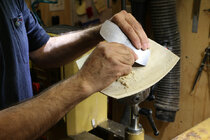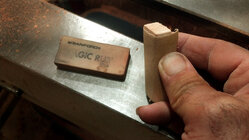I'm getting some end train tear out turning bowls. Most recently I turned a piece of Bhilwara but the problem is on multiple species so it's almost certainly a question of skill.
I finish with a NRS. At this point it seems like the key things are: stay sharp, light passes. Any other guidance here?
Also, I find that sanding with the lathe running does not improve the situation. I have to manually spot sand those areas, chasing a grain direction as I do. Am I pressing too hard? Would dampening the wood to soften fibers help? Shellac?
Thanks for any wisdom you can share.
Eric,
Endgrain tearout on the inside of the bowl, the outside, or both? Wet wood or dry. For most wood, I think tearout is an indication of too much force on the cut, the tool not sharp enough, or the cuts too deep or with too much force. I tend to turn at high speed and move the tool very slowly with light cuts. Life is too short to get in a hurry. Lathe speed slow, tool motion fast and aggressive cuts without sharp tools will almost guarantee tearout on end grain, especially on dry wood. (I almost always turn dry wood.)
Oh, and it should go without saying that cuts should be "downhill" on face work, rim to bottom on inside, base to rim on the outside. Opposite for end grain bowls.
If the tools are razor sharp (shaving sharp - I demonstrate on my left arm), and the tool control is good enough to make extremely fine "whisper" cuts, and NRS or shear scraping won't fix it, then consider the wood. If the wood is soft, punky, or brittle, it can indeed tear out when the end grain comes around, but will almost never tearout if the tool control is good. Some wood, however, is prone to tearout. Wild figure, such as highly burled or fiddleback maple, can have grain running in unpredictable directions making smooth cuts challenging.
What I and some others do is when approaching but still a good way from the final cut, start practicing final cuts on the piece so the "final" final cut is perfect. When practicing, might even switch tools to see if another tool/grind give a better result. Stop the late and examine for tearout often. If you get no tearout on the practice final cuts, you should get none on the finish cut.
If the wood is suspect, a coat of thinned shellac sander sealer can toughen up the fibers and allow for a cleaner cut. I don't use water on the piece.
I've gotten to almost always using a small Hunter Hercules tool for bowls and platters (and even some spindles). The tool never needs sharpening, just rotate the cutting bit and replace when it gets dull. Requires zero sharpening expertise!
After the final shaping cut I smooth away any tool marks with negative rake scrapers, ground with curved edges with both top and bottom bevels. Remove any grinding burr by stropping, then turn a small burr with a burnisher. I always follow the NRS with hand scrapers.
I have a sample piece from maple I show to students at at demos - a nearly square small dished platter divided into several sections on the top. One section is the finish cut off the tool - can feel the slight tool marks with the fingers, a second section is after smoothing with the NRS, and another one is after following that with hand scrapers and 600 grit sandpaper. 400 grit is usually sufficient, coarser than that is almost never needed. BTW, I NEVER sand with rotating disks on a drill and rarely sand by holding sandpaper against spinning wood. I prefer to sand by hand with the lathe turned off, usually with the piece taken off the lathe and held in a carving/finishing stand for sanding after hand scraping - more comfortable, can see better, get better results.
Using a hand scraper with work mounted on the stand, and my "soft sanding block" for hand sanding.


Do you turn spindles often? A number of pros recommend developing proficiency with spindle turning first, before face (bowl/platter) turning. They say, and I strongly agree, that spindle turning will teach the fine tool control that will let you turn anything. I start out all new students with the skew, then the spindle gouge, then practice with both. I have seen some by the end of one day of lessons turn perfect bowls on the first try after a small practice bowl to learn the gouge techniques.
If you get large areas of tearout, something is definitely wrong. If you have just a tiny spot or two, it's possibly a small local variation is the wood. John Lucas once taught me a "trick" for fixing a little spot with a few torn fibers: put a few drops of fine CA glue on sandpaper (maybe 320 or 220 depending on the wood and your turning skills), and wet-sand the spot. (Don't put the CA directly on the wood or it will stain.) The sandpaper picks up fine sanding dust, mixes it with the CA, and forces it into the tiny torn spots. Since it's picked up sawdust from the wood at the spot, it blends in nicely with the surrounding wood and usually makes an invisible fix.
If the tearout area is large, figure out why and fix that first. Problems like these can often be solved quickly with an experienced mentor at your side, watching, showing, and making suggestions. Many clubs have a list of mentors waiting to be asked! I have someone coming to my shop this weekend.
Oh, I never heard of the wood you mentioned but the Wood Database has this to say about Black Siris, Bhilwara, Albizia which might explain the challenge: "Moderately easy to work, though interlocked grain can cause tearout during surfacing operations." I have turned plenty of Albizia though, apparently the same species. This was one, a lidded box with turned brass. Sorry, don't remember any tearout!

JKJ




